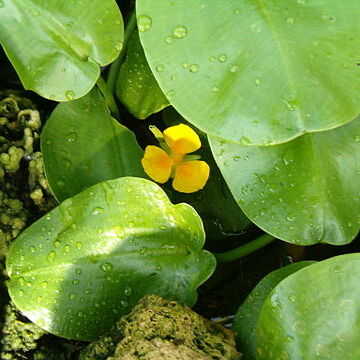Plants submersed, with floating leaves. Stems short, erect; stolons often present, terete. Leaves basal, floating or submersed, submersed sessile phyllodia, floating long-petiolate; petioles terete, septate, with a sheathing base; blades orbicular to oblong-lanceolate, margin entire, apex mucronate to obtuse, base rounded to cordate. Inflorescences of few to numerous flowers, terminating a long septate scape, proliferating with leaves and stolons, scapes few to many; peduncles terete, septate; bracts elliptic to lanceolate, delicate, separate, shorter than pedicel subtended. Flowers long-pedicellate, pedicels cylindric, terete; sepals green, coriaceous, erect, elliptic, apex cucullate, sometimes with a midvein; petals yellow to white, delicate, oblong-obovate to orbicular, falling off soon, erect to spreading, longer than or shorter than sepals; stamens 6-many, in 1-several series, outer often sterile, filaments linear or narrowly elliptic, flattened, anthers linear; carpels 5-8, terete, linear-elliptic, basally scarcely cohering, attenuate into style, styles curved inward, papillose at apex. Fruits more or less terete, linear-elliptic, membranous, without dorsal furrows, dehiscing along inner margins; seeds numerous, sparsely glandular pubescent.
More
Emergent aquatic, perennial or annual, stoloniferous, the juveniles usually submerged. Stems mostly floating, attached to substratum, rooting at nodes. Leaves radicalor in clusters along stem; petiole much longer than blade, with transverse septa; blade mostly floating, ovate to suborbicular, obtuse. Inflorescence of axillary clusters, umbels, or flowers solitary. Petals usually yellow. Stamens 6–numerous; staminodes usually present. Ovary superior; carpels usually 3 or 6 (–8), free or fused at base. Fruiting carpels linear-lanceolate, c. 15 mm long, united at base; style beak-like, persistent. Seeds small, curved.
Glabrous, lactiferous aquatic herbs. Stems rooting at nodes. Leaves floating. Flowers solitary, occasionally crowded; sepals 3, persistent; petals 3, delicate yellow, deciduous. Stamens many, outer staminodia. Carpels 3-6-(8), ± connate at base; style short. Follicles free, membranous. Spp. 4, of tropical S. America. Adventive sp. 1.

